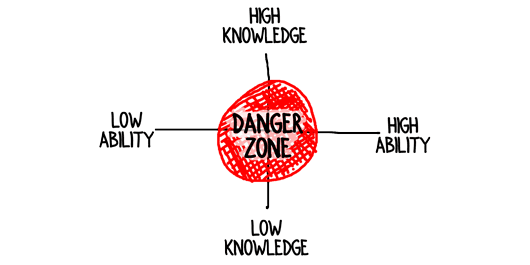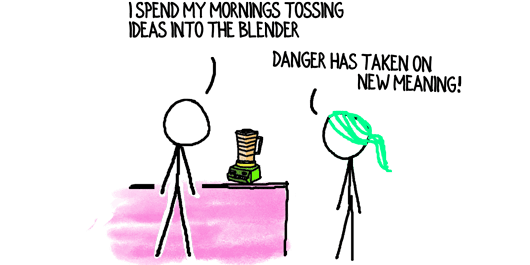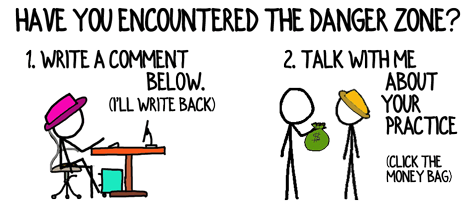I’m going to walk way out on a limb and assume you want to grow your consulting firm or your bank account and/or your personal capabilities.
Okay, it wasn’t much of a limb. More like lounging in a lawn chair while looking at the tree.
Regardless, there’s a Danger Zone that applies to every endeavor. From building your consulting firm to concocting tastier crumpets.
To understand the Danger Zone, let’s throw a couple of ideas in the blender:
Idea #1: To improve (a.k.a. grow) you need to know what to do and you have to be able to do it.
Idea #2: Good is the enemy of great; i.e., if you settle for good-enough you’ll never achieve audacious goals.
Push the blender’s ice-crush button and we come up with the following quadrant chart:

Most quadrant charts encourage you to migrate from “bad” boxes to the best box. But not this one.
In this case there’s a crazy Danger Zone lurking in the middle. That’s where you (or your consulting firm) has okay ability and a bit of knowledge, understanding or information.
For example, bad data puts your consulting firm at greater risk than no data.
Lacking any data you will proceed cautiously, test your way into decisions, and find errors in execution fairly inexpensively.
However, with bad data your consulting firm may proceed full steam ahead in the wrong direction, leading to very expensive errors.
When you think you know what to do, but your knowledge is limited, you’re in the Danger Zone
The other jaw of the Danger Zone traps you when you think you can do something well (or well enough) but you actually can’t (or shouldn’t).
For example, most small consulting firms squander precious time on bookkeeping, routine analysis, copywriting, and similar non-core activities. Offload those tasks to freelancers.
When you’re devoting precious resources to tasks you’re “good enough” at, you’re in the Danger Zone
Avoiding the Consulting Firm Danger Zone
Your two safety routes out of the Danger Zone are Perspective and Reliable Information.

Reliable information reduces the risk that you’re basing critical decisions on shaky data. A wider, unbiased perspective will alert you to poorly-conceived strategies, plans and behaviors.
That’s obvious, right? So, why does your consulting firm muck about in the Danger Zone?
- It’s difficult to gain perspective when you’re constantly ping-ponging between delivering projects and scrambling for new business. Nowhere in that mad cycle is there an obvious place to step back and consider long-term growth?
- You can’t see your own blind spots. The old bromide is true: “You can’t see your label from the inside of the bottle.”
- Reliable information is scarce when data is non-existent. When you don’t track anything, you don’t know where you are. If your consulting firm isn’t tracking useful metrics beyond revenue it’s no surprise you have a paucity of reliable information.
- Information is of little value unless you have benchmarks or experience. Let’s say you receive return calls from 50% of the prospects your consulting firm reaches out to. Is that good? Without benchmarks, you’re living in the Danger Zone.
Fortunately, obtaining Perspective and Reliable Information is straightforward:
Enlist Outside Viewpoints
Track Your Results
Access Benchmarks
For instance, peer groups, round tables, experts, advisers and mentors are all useful source of perspective. The right adviser(s) will also be able to tell you what to track and will offer benchmark data.
Does your consulting practice operate in the Danger Zone?
Probably.
The most insidious aspect of the consulting firm Danger Zone is that you rarely realize you’re in it. You think you’re lounging in the lawn chair when you’re actually teetering on a high limb.
Take an honest look at your consulting practice.
Is it possible you’ve been operating without reliable information or without soliciting perspective?
Text and images are © 2024 David A. Fields, all rights reserved.

 David A. Fields Consulting Group
David A. Fields Consulting Group 

While this concept is absolutely true and important, there is a different concept that goes by similar wording. And that is, that in terms of one day’s progress toward goals, good enough is best. That’s because good enough can be repeated consistently and compound toward excellent results. One day of crushing it followed by a month of congratulations and exhaustion that leads to no more action, actually gets us into the danger zone of thinking we’ve made meaningful progress when really we need to keep working.
There’s certainly a role for good enough, Julie-ann. After all, “Perfection is the enemy of completion.” The key here is to be aware. To realize that you don’t know what you don’t know and that some of your “good enough” may, in fact, be misdirected.
An injection of outside perspective and information are all it takes to know whether you’re doing just fine or heading toward a cliff.
Thanks for injecting your outside perspective, Julie-ann!